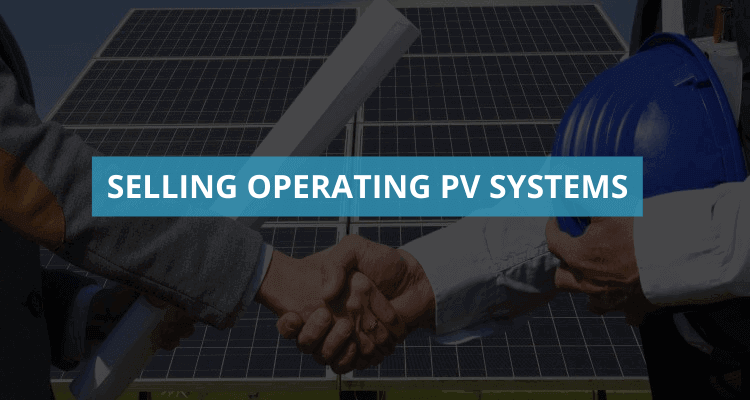Selling PV Systems In Operation – The What And The How
You can sell existing systems on the secondary market during operation: but how can you determine a price and find a buyer? Learn about the sales process and what to look out for.
Photovoltaic systems can be traded as assets on the secondary market, just as real estate can. Although PV direct investments have a balanced risk-return profile, there may be valid reasons for selling a PV system.
Common reasons for sale
Liquidity is the most common reason for selling. Entrepreneurial or private situations can suddenly change, requiring your tied-up capital to be made liquid at short notice.
Realising profits: The high demand for investment properties with a risk-return profile comparable to PV systems exceeds the supply. This means that the sale of an existing system can be very lucrative. Proceeds from the sale are then often reinvested in photovoltaics, allowing for the claim of special tax items.
Saving on time and stress: Operating and managing a PV system can be more time-consuming than initially assumed. For example, long trips to distant systems can be a burden. By selling, you free yourself from the existing obligations.
No matter your reason for selling your photovoltaic system, you’ll need to find a buyer. When looking for interested buyers, many turn first to their tax advisor, for an overview of any and all tax implications. System installers or acquaintances are also usually approached.
But contract and price negotiations are difficult when working with friends and family: a better method of negotiation is working with a broker specialised in the PV sector. Check the proportionality of the brokerage fee and whether a contractual marketing exclusivity is required.
This would narrow down your sales options. Alternatively, or concurrently, you can advertise your photovoltaic system on specialised online PV marketplaces such as Milk the Sun’s.
The sales process in three steps
Sales are processed in three steps on online marketplaces like Milk the Sun:
1. Determine sales value: Determine a fair market price for your photovoltaic system based on the current market value. For this purpose, all expected income and costs from the date of sale until the end of remuneration are discounted with a marketable comparative interest rate. Of course, you want to get the highest possible price for your offer, but the buyer’s goals also play a part: potential buyers want to earn interest on their investment amount.
A win-win situation can only be created for both sides if the system price can bring the buyer a return in line with the market and if your price expectations are met. You can easily calculate current value using Milk the Sun’s free, online net worth calculator.
2. Find investors: Due to high demand, there is a considerable amount of competition among investors on the Milk the Sun platform. In the demand market, numerous private and commercial investors, family offices, companies, funds, and asset management firms all compete with each other.
3. Prepare the sales process properly: Careful preparation is the be-all and end-all for a successful sales process. First of all, it must be ensured that the sale is even possible, in particular regarding the transfer of easements in the land register, and that a new investor may enter into the lease contract. You also need complete system documentation containing all documents and contracts as well as meaningful images of your system.
Milk the Sun provides you with competent advisors right from the start, who can help you to clarify detailed questions and ambiguities.
Common mistakes when selling PV systems
- Documentation is faulty or incomplete: Incomplete documentation makes a bad first impression on the investor. It costs both sides a lot of time and money.
- Price expectation is excessive: A price that is too high and not in line with the market will deter potential investors from the outset. However, it is wise to include a small price premium in the initial offer to make room for negotiation.
- Tax issues are not taken into account: If the possibility of unplanned additional tax burdens has not been clarified in advance with the tax advisor, negotiations may be broken off, even in late stages, or an economically unattractive sale may result.
- Financing costs are not taken into account: Most commercial PV systems are financed by banks. If it has not been clarified in advance with the bank how the financing will be handled in the event of a sale and the bank must first approve the sale, prepayment penalties may be incurred.
- Transaction time is incorrectly planned: If too little time has been planned in, the time pressure will put you in an unfavourable negotiating position.
- First ranking easement is not in the land register – the lessor stonewalls: If the entire lease has already been paid in advance, some lessors neglect to fulfil their part in the necessary transfer of the easements, or even look for an underhanded incentive in exchange for their cooperation. If the lease situation has not been fully clarified in advance, this can lead to a scandal afterwards during the sale.
This article was published in our investment guide. For all other articles and information on Direct investment in commercial-sized photovoltaic systems, please visit: Milk the Sun – PV Investment Guide.





